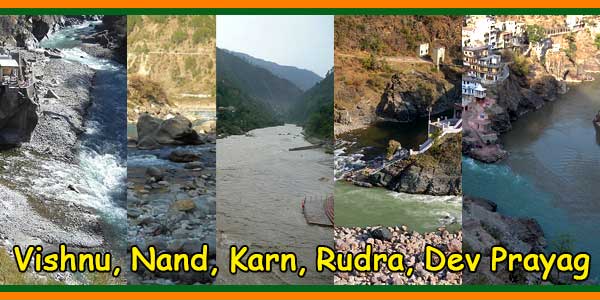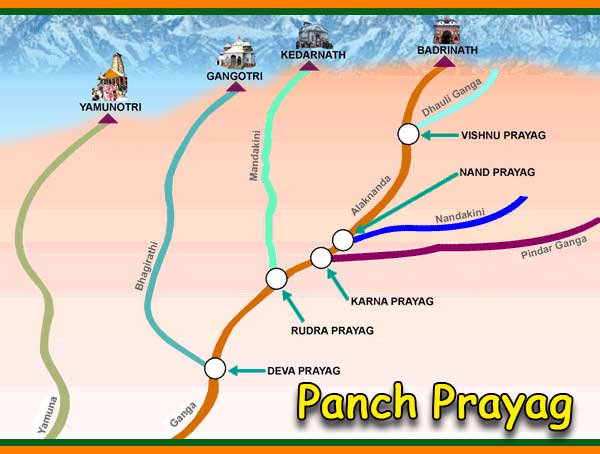About Panch Prayag in Uttarakhand:
5 revered sites in the Garhwal Himalayas in the state of Uttarakhand, where five rivers merge with the Alaknanda River to eventually form the sacred river the Ganges is called Panch Prayag. Panch Prayag meaning “panch” means five and “prayag” means confluence in Hindi. One of the holiest Indian rivers, the Ganges is revered as the life-giving goddess and its waters are used in religious rituals. These five places, in descending order of convergence of rivers, are Vishnu Prayag, Nanda Prayag, Karna Prayag, Rudra Prayag and Dev Prayag. Devotees from all over the country visit the sites, a dip in the water in these five places is believed to purify the soul and bring them one step closer to moksha.
According to Hindu mythology, when the goddess Ganges began her descent to Earth, her strength was formidable. To moderate its strength, it would have divided into 12 channels that flow to meet completely after Devprayag (where the Alaknanda and Bhagirathi rivers meet) to become the Ganges again.
The Garhwal people, in particular, gather at the five Prayags during the festivals of Makara Sankranthi, Uttarayan, Basant Panchami and Ram Navami to take a sacred bath at the confluences of the sacred rivers.

The distances from Rishikesh to the five prayags are:
- 256 km to Vishnu Prayag via Joshimath which is 13 km away.
- 190 km to Nanda Prayag.
- 169 km to Karna Prayag.
- 140 km to Rudra Prayag.
- 70 km to Dev Prayag.
Vishnu Prayag:
Formed by the confluence of the impetuous Vishnu Ganga (known after this point as Alaknanda) and the Dhauliganga river, Vishnuprayag (1372 m) has an ancient temple called Vishnu Kund. It is said that the sage Narad worshipped Lord Vishnu at this sanctified spot. Visitors will find the Kagbhusandi Lake bewitching with its emerald green depths giving it a still surface, while on the banks, blossoms evoke the colors of nature in all her glory. The lake can also be approached from Vishnuprayag beside Bhundhar village near Ghangaria.
Along with its religious significance, Vishnuprayag is also a popular destination for adventure seekers as it offers trails for trekking and hiking. A few noted treks include the Valley of Flowers, Kagbhusandi and Hemkund Lake.
Nanda Prayag
The next confluence happens in Nandaprayag where Rivers Alaknanda and Nandakini meet. There are several legends associated with this site. According to one, it is believed that a pious and honest king named Nanda performed a yajna or fire ritual here to please the gods and seek their blessings. Another legend goes to say that Nandaprayag derived its name from Nanda, the foster father of Lord Krishna. The famous Gopalji temple is also situated here.
Karna Prayag:
Karnaprayag is located on the way to Badrinath and is the site of the confluence of two holy rivers Alaknanda and Pindar. It is said that Karna of Mahabharata meditated here for many years to acquire the impregnable shield, which made him a formidable warrior on the battlefield. Swami Vivekananda is also known to have meditated here with his disciples. It is the sub-divisional headquarter of district Chamoli. Roads from here go to Almora, Nainital and Jim Corbett National Park.
Rudra Prayag:
Named after Lord Shiva (Rudra), Rudraprayag is a small pilgrim town located on the holy confluence of river Alaknanda and Mandakini and is venerated as one of the five sacred confluences or the ‘Panch Prayag’. The meeting of the Mandakini and Alaknanda rivers has a unique beauty of its own and appears as two sisters embracing each other. It is believed that to master the mysteries of music, Narad Muni worshipped Lord Shiva, who appeared in his Rudra Avtaar (incarnation) to bless Narad.
The Shiva and Jagdamba temples are of great religious importance. Till recently, Rudraprayag was a part of district Chamoli and Tehri. In 1997, the Kedarnath Valley and parts of district Tehri and Pauri were conjoined to form Rudraprayag as a new district. It is the junction for visiting Badrinath and Kedarnath Dham.
There are several temples worth visiting in Rudraprayag, one of the most prominent being the Koteshwar Mahadev Temple on the shores of the Alaknanda river. Covered in lush foliage, this beautiful cave temple is dedicated to Lord Shiva, who is believed to have stopped and meditated here.
Dev Prayag:
The last prayag or confluence, Devprayag (850 m) is a pilgrimage town in the Tehri Garhwal district of Uttarakhand. Alaknanda and Bhagirathi rivers merge to form the holy River Ganga at Devprayag. The small town is situated on the route from Rishikesh to Badrinath.
Devprayag literally means ‘holy confluence’. It is an extremely important religious site for Hindus. Ganga, the biggest and the holiest river in India, starts its journey to the plains and further towards the Bay of Bengal from Devprayag.
The entire town was destroyed in 1803 by an earthquake but the heritage structures of Devprayag were restored soon and the ancient charm of the holy town has been retained.
